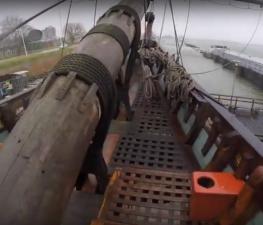 In the United States recently, there has been a lot of attention given to those who hoard toilet paper in preparation for the coronavirus onslaught. As toilet paper is one of the basic necessities of modern life, hoarding seems to be particularly bad form. Nevertheless, as we consider the prospect of doing without, it also raises the question of what folks did before the advent of toilet paper. This being a nautical blog, however, we will focus on how sailors of old kept their bums more or less clean.
In the United States recently, there has been a lot of attention given to those who hoard toilet paper in preparation for the coronavirus onslaught. As toilet paper is one of the basic necessities of modern life, hoarding seems to be particularly bad form. Nevertheless, as we consider the prospect of doing without, it also raises the question of what folks did before the advent of toilet paper. This being a nautical blog, however, we will focus on how sailors of old kept their bums more or less clean.
Sailors in the Age of Sail used tow-rags. What is a tow-rag? As can be seen in the video below, close to the ship’s head — the toilets in the bow or “head” of the ship — there was a long rope ending in a short rag that hung over the side into the water. After using the head, the sailor could then clean his backside with the wet rag then drop the rope back over the side. The rag would then be cleaned either by being literally towed by the ship under sail or to be washed by the action of wave and current if at anchor.
The word “tow” may refer to the process of the rage being towed underway but is more likely to be the type of hemp woven rag used at the end of the rope, referred to, even today, as tow.
In modern British slang, a tow-rag, also spelled toerag, is a low-life, scum, or loser. Recently an elderly constituent’s comments on Prime Minister Boris Johnson went viral when she referred to him as a “filthy piece of toerag.” Toerag is not slang used widely on this side of the Atlantic, although it translates nicely into American English as the equally impolite “ass-wipe.”
Here is a short video taken on the replica ship, Batavia which shows a tow-rag and describes how it used.

So is this why bathrooms are often called “head”. Because on the ship the seat was found at the head? Granted officers may have had someplace seperate.
BTW? The link to the vid no longers works at the time of this posting.
An error occurred. Please try again later. (Playback ID: 5g2E7owrxBpqpn02)
Thanks Rick
I will be able to amaze my friends with this wonderful information, probably several times until they threaten injury 🙂
Back in the day, while sailing with a number of 27′ whalers down the Trent Canal, the problem was solved by towing the person himself. Not so eco-friendly but it did serve the purpose. No facilities were handy when natural demanded immediate attention.
Shit gets real. Thanks for sharing what people (sailors) did for centuries before toilet paper was invented! There is more than one way to clean an ass. (Is this too much foul language?)
@Willy
It is called ‘the head’ or more properly ‘the heads’ because that term describes the construction of the bow of wooden ships in which the planks are/were steamed and bent to fit the narrowing of the frame, and thus attached to the rabbet of the prow or stem. When the ‘bows’ starboard and port are attached, one can go the ‘heads’ on either side, or to the head is only one side has the seat as in the video.
Source: Adm. WHSmythe Word Book ca. 1867
The structural area protruding out the front of the hull is called the beakhead, later the head. Its original purpose was to hold down the bowsprit which was there to keep the mast fro falling backward. They later hung a sail on, put a small mast at the ned of it, then stuck jibs and staysails on it. Since it was right next to the area that the sailors lived – the forecastle or fo’c’sle – it was a handy place to put the toilet. In Master and Commander there is shot of them rounding the horn in the snow with an old sailor shivering on the head
One wonders how Patrick O’Brian missed this delicate detail…
Pingback: Shortages or not, be thankful for your toilet paper! – Bayou Renaissance Man